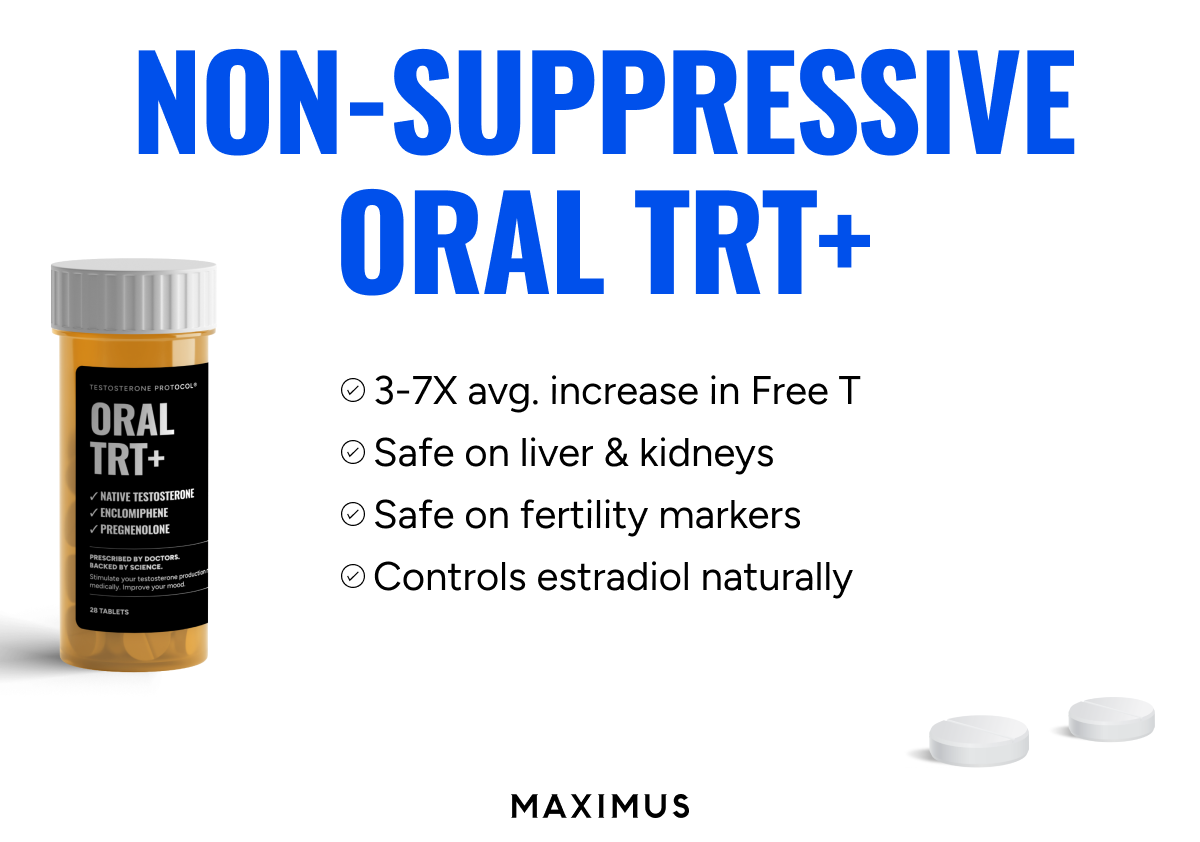Table of Contents
By Ben House |PhD,CFMP,CN, FDN, fNMT, Functional Medicine Costa Rica
I remember mowing through Muscle and Fitness magazines when I was 18, then pounding three scoops of NO xplode™ and dismantling 8 combinations of supersets, all in the name of chasing down that post workout elevation in testosterone and growth hormone. It worked, and I thought it was going to work…and more than that, I was 18 and relatively undertrained.
Is Testosterone the Holy Grail of Exercise Adaptation?
To start this conversation you must have an understanding of the male hypothalamic pituitary gonadal (HPG) axis, aka how the male body signals the testicles to produce testosterone. This all starts in the brain with the hypothalamus secreting gonadotropin-releasing hormone (GnRH), which it does like all hormones in a pulsatile fashion. GnRH then tells the pituitary to release follicle stimulating hormone (FSH) and luteinizing hormone (LH). FSH acts on the Sertolli cells and says, “Hey guys, light up some sperm production.” LH on the other hand tells the Leydig cells to uptake cholesterol (which is dependent on thyroid hormone) and ramp up androgenesis AKA testosterone production.
Here is a very basic diagram of this process.
The diagram above is an oversimplification, and as you would guess, the whole story is a lot more complicated as to what other factors regulate this axis, and there are also things we undoubtedly don’t know yet. Below is the more complicated version of the diagram.
On this diagram it is evident that a lot of substances are acting on the hypothalamus. Let’s bullet up the big rocks:
- The major regulator of GnRH secretion is Testosterone itself; this is called negative feedback inhibition. This means that if testosterone is high, the signal to make more testosterone would go down. This is why we must be absolutely certain that a male needs exogenous testosterone because long term TRT will shut down this communication at the level of the brain. The body is efficient above all else, so if it is getting something exogenously, it won’t see a need to produce it endogenously.
- Corticotropin-releasing hormone (CRH) inhibits GnRH secretion and testosterone production. CRH is the master hormone released by the hypothalamus of the hypothalamic-pituitary adrenal (HPA) axis. Furthermore, cortisol, one of the end products of the HPA axis, also inhibits androgenesis at both the gonadal and hypothalamic areas. Thus, you can begin to see how dysregulation of the stress response and overtraining can inhibit testosterone production. And this makes sense physiologically because if we are running from a real or proverbial tiger, we are not
worried about things like reproduction, muscle growth, or the lusciousness of our beards (which is actually more related to DHT). Leptin, which is essentially a long-term fuel gauge hormone secreted by adipose tissue, has a positive effect on GnRH, whereas ghrelin, a hunger hormone released from the stomach, has an antagonistic effect. This may be one of the reasons we see testosterone go down significantly when males calorie restrict beyond 15%. However, research has shown that these depreciations are not directly dependent on hunger hormones cueing us in that the human brain likely has other means of sensing energy availability very quickly. So f*ckin cool.
Now that we have an understanding of how the HPG axis functions, let’s ask some big questions.
How Does Exercise Affect Testosterone levels?
Globally, that’s actually fairly simple. Short, acute, intense sessions (lifting and even sprinting) usually increase testosterone (transiently), while prolonged exercise usually reduces serum testosterone levels acutely and chronically. Go ahead read that last sentence again. It’s important. Men both young and old get this acute hormonal spike in testosterone, and even more so with growth hormone, yet both elevations dissipate in 30-60 min following an appropriate exercise bout. Furthermore, this spike has been found to be larger in younger men, and it is at most 1.25- 2x physiological. Recent research also questions if this is in fact more of a hemoconcentration mechanism than an actual rise in real testosterone levels.
Nevertheless, the bigger question.
Do acute post-exercise hormonal secretions mediate increases in muscle size and adaptation?
This is called the hormone hypothesis, and it is a giant mayberolled in sprinkles of real world insignificance. That said, at the limits of what’s possible, everything matters, so as S&C professionals, we stay interested.
“My take based on the current body of evidence: While I can't dismiss that acute hormonal elevations may play a role in the growth process, I'm quite confident in saying that if such an effect does in fact exist, it would be of small consequence.”
-Dr. Bard Schoenfeld
Now to dig deeper, we have to have some understanding of how muscles grow, and I will defer to Dr. Brad Schoenfeld again…
“Postexercise hypertrophic adaptations are mediated by a complex enzymatic cascade whereby mechanical tension is molecularly transduced into anabolic and catabolic signals that ultimately lead to a compensatory response, shifting muscle protein balance to favor synthesis over degradation.”
If you want more than this sentence, I would refer you to Dr. Pat Davidson’s series What CausesMuscle to Growand/or Dr. Schoenfeld’s fantastic tome - The Science and Development of Muscle Hypertrophy.
https://www.amazon.com/Science-Development-Muscle-Hypertrophy- Schoenfeld/dp/149251960X
Now how does testosterone fit into this process? As most of you know from the media, testosterone is in fact anabolic (gasp) in that it attenuates protein breakdown and promotes protein synthesis, as well as promotes the release of other anabolic hormones like growth hormone (GH) and insulin-like growth factor 1 (IGF-1). The hypothesis now being that if you have more testosterone hanging around after exercise, more will bind to the androgen receptor, and this will turn the ship around faster and produce a heightened response to said training load.
At this point, some of you may be wondering why I am talking so much about this post-exercise transient increase in testosterone concentrations. This is because in the research, strength training has not been found to raise basal (resting) levels of testosterone, and this in my mind is where functional medicine (more just being smart and accumulating the right data) comes into play for both male and female athletes.
The science on the importance of the post-exercise rise in anabolic hormones is far from black and white, and studies have found that muscle growth can occur in the absence of this post- exercise hormonal increase, and that increases in post exercise hormone concentrations may not be related to further increases in muscle growth in response to resistance training. Thus, these hormonal elevations mayheighten muscular growth (and even increase androgen receptor concentrations), but may not be absolutely necessary. These increases have also notbeen found to be mediated by LH secretion and are more likely a result of the activation of the sympathetic nervous system during training.
On the other end of the spectrum, there is no debating that exogenous testosterone administration can produce increases in muscle size and decreases in body fat, and these effects are increased when strength training is added. Yet, these administered levels are relatively constant and supraphysiological, and an interesting study from 2001 spells this out rather well. Bhasin et al. suppressed GnRH secretion in 61 eugonadal men age 18-35 years and then broke the subjects into groups given different graded doses of testosterone for 20 weeks. These participants were actually asked not to train, and the diet was standardized between groups. Compliance was extremely high, as only one man missed one injection. Yeah, if you shut my brain off, I probably wouldn’t have blown off the needle either.
Here is what the different group’s testosterone levels looked like at baseline and week 16.
It worked, and expectedly serum LH levels were suppressed in all groups, and testosterone increased in a dose dependent fashion. Yet, only the bottom three groups were inside physiological ranges at their lowest points (nadir), and this is why most men on TRT get put on biweekly or weekly injections, whereas in the natural state, the HPG axis is constantly ramping testosterone up and down throughout the day and even through the seasons.
Now let’s take a look at what happened to body comp.
That’s right, without exercise the 600mg group gained 20 lbs of muscle and lost about 5 lbs of fat in 20 weeks without working out and no real changes to their diet. Now the average bodybuilder dose is 1100 mg. Whew. Hello CT Fletcher Biceps and being able to say, “You overtraining mothaf*ckas make me sick. There ain’t no motha*cking thing as overtraining. It’s a myth.” Over 1 million YouTube™ views and his words, not mine. Just sayin’. To each their
own.
Now the really interesting stuff happened at 300 and 125mg. The 300mg group’s nadir was well above physiological, whereas the 125mg group’s nadir was right at where they were before, but even with this constant blare of testosterone, they gained more than 6 pounds of muscle with no real stimulus.
This research is cool unless you are a participant and had your hypothalamus shut down for 20 weeks without any sort of reset protocol. But, it still isn’t real life, and I have not seen a single study that looks at differences in muscle size or strength in response to the same resistance training protocol based on basal hormonal values inside of physiological ranges. Interestingly, at
the population level, no differences in testosterone (both free and total) were seen between top- class athletes and untrained controls. But would having a basal testosterone level of 850 ng/dL compared to 400 ng/dL result in an elevated response to the same resistance training program, when keeping all other things constant (nutrition, sleep, stress, etc)?
We do not know the answer to that question, and we may never know, as running this type of randomized controlled trial (RCT) would be extremely difficult, and the selection process would also be quite costly from both a financial and time standpoint. BUT a few studies kind of, sort of, maybe give us some insight.
Mouser et al. retrospectively looked at the testosterone levels of 251 men 18-85 years and their body composition data via DEXA, all one point in time. They found that, “men with total testosterone levels in the 3rd and 4th quartile had a greater relative amount of lower-body lean mass and decreased lower-body fat mass and upper-body fat mass compared to those in the 1st quartile.” And this finding was still significant when they put race, age, self-reported moderate to vigorous physical activity, C-reactive protein, and dietary protein intake into the model. The third quartile had an average testosterone of 589 ng/dL and the forth 717 ng/dL, while the first had an average of 348 ng/dL, yet not even lab low. These values are intriguing as the optimal cut off in the func med world tends to be 550 and some even hold it at a very lofty 700.
This is a retrospective cross-sectional analysis in a modest sample size that highlights the need for more research, thus don’t get handsy with the word causal.
Now the question you might begin to ponder is are there some absolute testosterone values that human males need to put on muscle? Good, we are in the same boat. The HORMA trial sought to investigate if there was a threshold testosterone level that was necessary to enhance skeletal muscle strength and function in men age 65-90 years. 112 participants were again treated with a GnRH agonist combined with 5 or 10 grams of a transdermal testosterone gel and varying doses of self-administered recombinant growth hormone injections for 16 weeks. “Total testosterone levels increased by 143 ± 379 ng/dL (p= .006) with the 5 g dose and by 510 ± 503 ng/dL (p<
.0001) with the 10 g dose.”
“Accordingly, we determined the magnitude of change in testosterone levels (including participants who had declines in levels below baseline values) necessary to increase LBM by 1.5 kg and ASMM by 0.8 kg. For participants who received only testosterone increases in total testosterone of 1046 ng/dL (95% confidence interval = 1040–1051 ng/dL) and 898 ng/dL (95% confidence interval = 892–904 ng/dL) were needed to increase LBM by 1.5 kg and appendicular skeletal muscle mass (ASMM) by 0.8 kg.”
I would put a giant asterisk after this study with *in older men without a lifting regiment.
So pretty high levels in the elderly result in modest changes in muscle mass without any kind of exercise regiment. Thanks. Not groundbreaking by any means, and we still need some research that has an exercise arm. Please, for the love of Zeus.
However, we do very much know that prolonged chronic endurance exercise leads to dysfunction in the HPG axis. Cross-sectionally and prospectively, many studies have found depressed testosterone levels in endurance trained athletes compared to sedentary controls, and these levels are consistently in the low-normal range. This lowering of basal testosterone levels is not accompanied by a rise in LH (which would be expected). In fact, LH has been found to stay the same or even decrease in response to chronic endurance training, and the mechanism of this reduction in basal testosterone levels has yet to be determined, but it is likely to involve a milieu of other hormonal changes, like the increase in CRH and cortisol, which have been found to inhibit the HPG axis at both the brain and testicular level.
So What’s the Final Rub?
Testosterone is important. It follows a circadian rhythm (why you stand at attention in the early morning hours) and levels peak in the late teens or early twenties and then plateau until the thirties or forties, when testosterone starts decreasing by 1-2% per year. However, I have become less and less apt to just accept this fate, as I have tested plenty of men in their fifties and sixties who have completely natural testosterone levels well above 550 and 700 ng/dL. I now believe that this commonly cited population-wide reduction in testosterone is more of a factor of our current estrogenic, frazzled, blue light-ridden environment than a guaranteed slow death
sentence.
A few Oh Shit quotes to ponder.
“A 35 year old male in 2005 had about 20 percent less testosterone than a man of hisfather’s generation of the same age.”
-Antti Perheentupa, MD, PhD
And the storm doesn’t look to be receding.
“A 65-year old man in 2014 will, under typical circumstances, have testosterone levels that are 15 percent lower than a 65-year old man in 1999.”
-Travison et al.
Nevertheless, testosterone is not the end all be all for what we do in the weight room, but if you asked any man if he wanted high physiological or low physiological levels, you can guess his response. And low or even low-normal levels can be indicative of more overall stress than the system can handle, as we know both chronic physical and psychosocial stress will wreak havoc on the HPG axis. Thus, the inclusion of testing basal levels in one’s eval process is highly recommended to establish if someone is tanked or tanking. This can then add buy-in for what you can do from a lifestyle standpoint to potentially bring those values back up. I have seen men raise their basal levels anywhere from 200 to 500 ng/dL in 90 day protocols with a whole conglomeration of lifestyle factors and micronutrients (no I don’t think there are any real supplements that raise testosterone significantly – if they existed, they would be illegal). Continued testing is then advisable throughout the life course as a barometer of total accumulated stress (environmental, physical, and psychosocial) and the functioning of the HPG axis.
Research is generally displayed in populations and averages, and what matters most is the individual. This is why knowing both the state of the research and your own system is so pivotal. When or if I have a son, I will start getting annual testosterone levels on him beginning at puberty, so he knows physiologically where he stands, and then he can track that value as he ages if he so chooses.
To finish, whenever things get complicated, whether it be analyzing human movement, nutrition, or hormonal status, I always go back the fundamentals. And what are the things we know knock down testosterone? Lack of sleep, obesity, endogenous and exogenous estrogens, stress, blood sugar dysregulation, excessive caloric restriction, overtraining, and micronutrient deficiencies.
All these variables are testable and changeable in your clients. Isolate the limiting factors and get to work, and also investigate any previous anabolic use, blunt trauma to the testicles, varioceles, or traumatic brain injuries. And then give the body some time.
As one of my favorite undergraduate and University of Kansas medical school professors, Dr. Roger Lindberg said, “90% of all human problems will fix themselves if you give the body what it needs and time.”
Oh, and don’t forget to lift.
By: Ben House
References:
1. Constantini NW, Hackney AC. Endocrinology of physical activity and sport.2nd ed.
New York: Humana Press; 2013.
2. Schoenfeld BJ. Postexercise hypertrophic adaptations: a reexamination of the hormone hypothesis and its applicability to resistance training program design. J Strength Cond Res.Jun 2013;27(6):1720-1730.
3. Hayes LD, Bickerstaff GF, Baker JS. Interactions of cortisol, testosterone, and resistance training: influence of circadian rhythms. Chronobiology international.Jun
2010;27(4):675-705.
4. Vingren JL, Kraemer WJ, Ratamess NA, Anderson JM, Volek JS, Maresh CM.
Testosterone physiology in resistance exercise and training: the up-stream regulatory elements. Sports medicine.Dec 1 2010;40(12):1037-1053.
5. Kraemer WJ, Ratamess NA. Hormonal responses and adaptations to resistance exercise and training. Sports medicine.2005;35(4):339-361.
6. Rubin DA, Pham HN, Adams ES, et al. Endocrine response to acute resistance exercise in obese versus lean physically active men. European journal of applied physiology.Jan
30 2015.
7. Hackney AC, Szczepanowska E, Viru AM. Basal testicular testosterone production in endurance-trained men is suppressed. European journal of applied physiology.Apr
2003;89(2):198-201.
8. Daly W, Seegers CA, Rubin DA, Dobridge JD, Hackney AC. Relationship between stress hormones and testosterone with prolonged endurance exercise. European journal of applied physiology.Jan 2005;93(4):375-380.
9. Hackney AC. Effects of endurance exercise on the reproductive system of men: the
“exercise-hypogonadal male condition”. J Endocrinol Invest.Oct 2008;31(10):932-938.
10. West DW, Phillips SM. Anabolic processes in human skeletal muscle: restoring the identities of growth hormone and testosterone. The Physician and sportsmedicine.Oct
2010;38(3):97-104.
11. Travison TG, Araujo AB, O'Donnell AB, Kupelian V, McKinlay JB. A population-level decline in serum testosterone levels in American men. J Clin Endocrinol Metab.Jan 2007;92(1):196-202.
12. Perheentupa A, Makinen J, Laatikainen T, et al. A cohort effect on serum testosterone levels in Finnish men. European
journal of endocrinology / European Federation of Endocrine Societies.Feb 2013;168(2):227-233.
13. Ip EJ, Barnett MJ, Tenerowicz MJ, Perry PJ. The Anabolic 500 survey: characteristics of male users versus nonusers of anabolic-androgenic steroids for strength training. Pharmacotherapy.Aug 2011;31(8):757-766.
14. Hackett G, Cole N, Bhartia M, et al. The response to testosterone undecanoate in men with type 2 diabetes is dependent on achieving threshold serum levels (the BLAST study). International journal of clinical practice.Feb 2014;68(2):203-
215.
15. Sattler F, Bhasin S, He J, et al. Testosterone threshold levels and lean tissue mass targets needed to enhance skeletal muscle strength and function: the HORMA trial. The journals of gerontology. Series A, Biological sciences and medical sciences.Jan 2011;66(1):122-129.
16. Bhasin S, Woodhouse L, Casaburi R, et al. Testosterone dose-response relationships in healthy young men. Am J Physiol Endocrinol Metab.Dec 2001;281(6):E1172-1181.
17. Mouser JG, Loprinzi PD, Loenneke JP. The association between physiologic testosterone levels, lean mass, and fat mass in a nationally representative sample of men in the United States. Steroids.Aug 17 2016;115:62-66.















